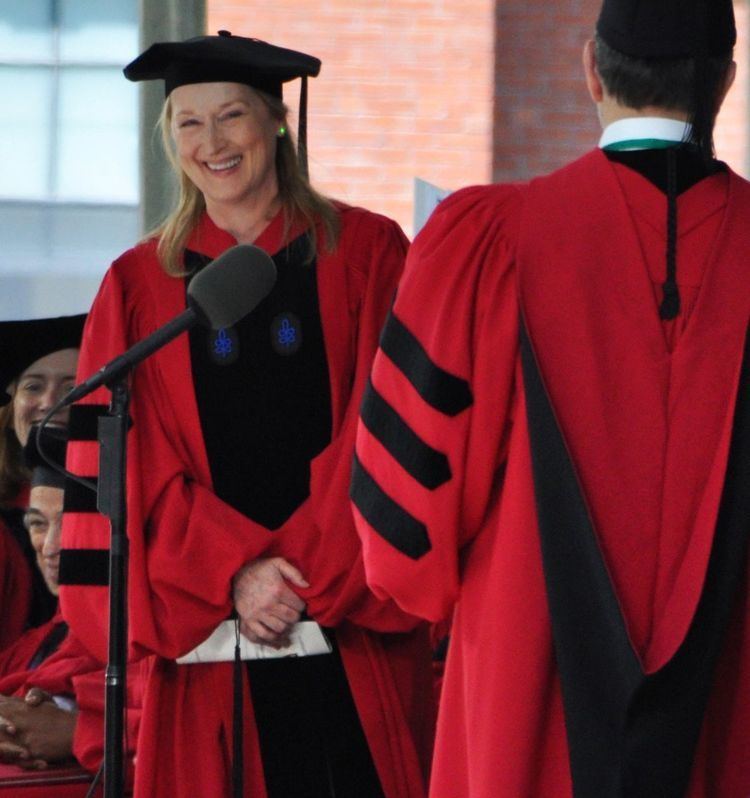 | ||
What was originally called Harvard Colledge (around which Harvard University eventually grew) held its first Commencement in September 1642, when nine degrees were conferred. Today some 1700 undergraduate degrees, and 5000 advanced degrees from the university's various graduate and professional schools, are conferred each Commencement Day.
Contents
- Daybreak rituals
- Morning Exercises
- Academic Parade
- Holyoke Chair
- Ceremonies
- Mid day ceremonies
- Alumni Association meeting and afternoon addresses
- References
Each degree candidate attends three ceremonies: the Morning Exercises, at which degrees are conferred verbally en masse; a smaller midday ceremony (at the candidate's professional or graduate school, or upperclass House) during which actual diplomas are given in hand; and in the afternoon the annual meeting of the Harvard Alumni Association's, at which Harvard's President and the day's featured speaker deliver their addresses.
Several hundred Harvard honorary degrees (which with few exceptions must be accepted in person) have been awarded since the first was bestowed on Benjamin Franklin in 1753. In 1935 playwright George Bernard Shaw declined nomination for a Harvard honorary degree, suggesting instead that Harvard celebrate its three-hundredth anniversary by "burning itself to the ground ... as an example to all the other famous old corrupters of youth" such as Yale.
The ceremonies shifted from late summer to late June in the nineteenth century, and are now held at the end of May. A number of unusual traditions have attached to them over the centuries, including the arrival of certain dignitaries on horseback, occupancy by Harvard's president of the Holyoke Chair (a "bizarre" sixteenth-century contraption prone to tipping over) and the welcoming of newly minted bachelors to "the fellowship of educated men and women."
Daybreak rituals
Most upperclass Houses have rituals of their own. At Lowell House, for example, a perambulating bagpiper alerts seniors at 6:15 am for a 6:30 breakfast in the House dining hall with members of the Senior Common Room, after which all process (along with members of Eliot House, who have been similarly roused) to Memorial Church for a chapel service at 7:45.
Morning Exercises
Morning Exercises are held in the central green of Harvard Yard (known as Tercentenary Theatre), the dais at the steps of Memorial Church, facing Widener Library. Some 32,000 people attend the event, including university officials, civic dignitaries, faculty, honorees, alumni, family and guests. Degree candidates wear cap and gown or other academic regalia (see Academic regalia of Harvard University).
Academic Parade
The first to enter are candidates for graduate and professional degrees, followed by alumni and alumnae. Candidates for undergraduate degrees enter next, traditionally removing headgear as they pass the John Harvard statue en route. Finally comes the President's Procession, as follows:
Holyoke Chair
On the dais the President occupies the Holyoke Chair, an uncomfortable and treacherous Jacobean turned chair reserved for such ceremonies since at least 1770 (when it was already some two hundred years old). Called "bizarre ... with a complex frame and top-heavy superstructure", its "square framework set on the single rear post makes [it] tip over easily to either side." Said the Harvard Gazette in 2007, "When the chair holds its robed occupant, onlookers cannot detect the odd geometry by which its triangular seat points toward a square back rippling with knobby dowels and finials. Perhaps by striking their own precarious balance in this strange seat of authority, the successors of Edward Holyoke [Harvard's president 1737–69] come to sense what the job is all about."
Ceremonies
At the University Marshal's call ("Mister Sheriff, pray give us order") the Middlesex Sheriff takes to the dais, strikes it thrice with the butt of his staff, and intones, "The meeting will be in order." Three student speakers (Undergraduate English, Undergraduate Latin, and Graduate English) are introduced and deliver their addresses.
Then, according to the order in which the various graduate and professional schools were created, the dean of each school steps forward to present, en masse, that school's degree candidates. Each group stands for the President's incantation conferring their degrees, which is followed by a traditional welcome or exhortation: doctoral graduates, for example, are welcomed "to the ancient and universal company of scholars", while law graduates are reminded to "aid in the shaping and application of those wise restraints that make us free." Last to be graduated are the Bachelor's candidates, who are then welcomed to "the fellowship of educated men and women."
Honorary degrees are then bestowed. Finally, all rise to sing "The Harvard Hymn", expressing the hope (Integri sint curatores, Eruditi professores, Largiantur donatores—
Once the dais is clear the Harvard Band strikes up and the Memorial Church bell commences to peal, joined by bells throughout Cambridge for most of the following hour.
Mid-day ceremonies
After the Morning Exercises, each graduate or professional school, and each upperclass House, holds a smaller ceremony (with luncheon) at which its member-graduates are called forward by name to receive their diplomas in hand.
Alumni Association meeting and afternoon addresses
At the afternoon meeting of the Harvard Alumni Association, the President and the Commencement Day speaker deliver their addresses.
US Secretary of State (and former Army general) George C. Marshall's 1947 address as Commencement Day Speaker famously outlined a plan (soon known as the Marshall Plan, and for which he would later be awarded the Nobel Peace Prize) for the economic revival of post-World War II Europe.
